Here you’ll discover a compilation of 18 familiar British birds, complete with captivating imagery and intriguing facts about each type. This collection encompasses not just birds found in gardens, but also those inhabiting woodlands, cities, and coastal areas, providing a valuable introduction to the diverse avian species in Britain.
We believe that it is essential for everyone residing in Britain to be able to recognize most, if not all, of the birds featured in this list!
While going through the list, take a moment to tally up how many of these common British birds you can identify. Feel free to share your results in the comments section below!
It’s worth noting that many of these birds can also be spotted in other regions around the world. If you are not a resident of Britain, kindly inform us of your location and indicate which of these species can also be found in your country!
18 Common British Birds: List With Pictures & Facts
Blackbird

Scientifically referred to as Turdus merula, the blackbird is a widely recognized bird species in Britain. It frequently visits gardens, parks, and woodlands, where it can be observed searching for food amidst the grass. Its diet primarily comprises insects, worms, seeds, and berries.
The adult male blackbird stands out unmistakably with its entirely black plumage and a vibrant yellow-orange beak. On the other hand, females and juveniles exhibit a dark brown coloration, often accompanied by streaks or speckles on their chests.
Renowned for its enchanting and melodious song, the male blackbird takes center stage as a prominent contributor to the dawn chorus.
Blue Tit
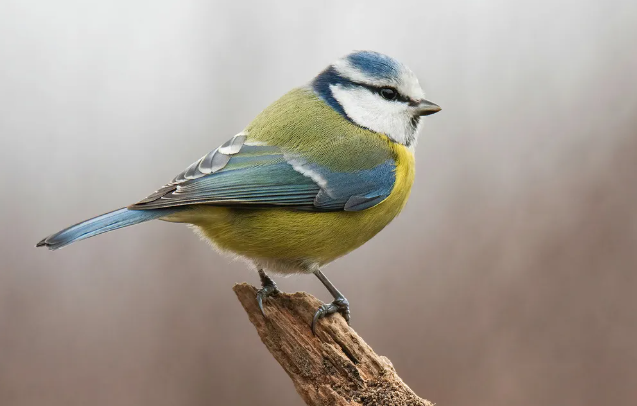
Officially known as Cyanistes caeruleus, the blue tit is a frequent sight in British gardens and woodlands. It boasts vibrant colors, with a white face, a striking blue “hat,” and a black “superhero” mask. Its wings and tail are tinted in a blue-grey shade, while its chest gleams with a sunny yellow hue.
For those who provide bird feeders, the blue tit is likely to become a familiar and regular visitor. While observing this small avian species, it’s important to note the distinguishing features that set it apart from its larger relative, the great tit. Unlike the blue tit, the great tit possesses a completely black head from the eyes upward. Remembering the blue hat and black mask will ensure you never mistake one for the other.
Buzzard
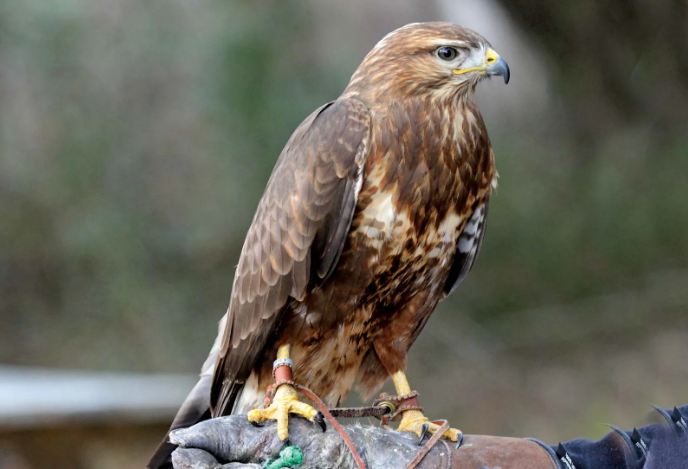
Known by its scientific name Buteo buteo, the buzzard is a prevalent bird of prey in Britain. During the summer, approximately 67,000 pairs of buzzards inhabit the region, making it the most common of its kind. These majestic creatures can be found throughout Great Britain and the eastern parts of Ireland.
Buzzards are often spotted soaring high in the sky, gracefully gliding or circling with their broad wings forming a shallow V shape. Alternatively, you may come across them perched on tree branches or telegraph poles by the roadside.
Their diet primarily consists of voles, birds, rabbits, and other small to medium-sized vertebrates. However, they are not averse to consuming worms and insects as well.
When exploring the open countryside, pay attention to a sound resembling a mewing cat. It could be the call of a buzzard, circling the vicinity and communicating with its mate.
Canada Goose

Officially known as Branta canadensis, the Canada goose is a remarkable avian species found predominantly in reservoirs and other expansive bodies of water. Originally introduced to Britain from North America approximately three centuries ago, this bird has experienced a substantial population surge in recent times, leading to its classification as a nuisance in certain regions.
Distinguished by its substantial size and predominantly grey plumage, the Canada goose boasts a distinctive black neck and head adorned with a white chin patch. It is frequently observed congregating in significant numbers near reservoirs.
When in flight, Canada geese frequently exhibit a captivating V-shaped formation, aptly referred to as “skeins.” This aerodynamic pattern serves to conserve the birds’ energy during flight. Within the formation, the geese often rotate positions, affording the leading bird an opportunity to recuperate and catch its breath.
Carrion Crow
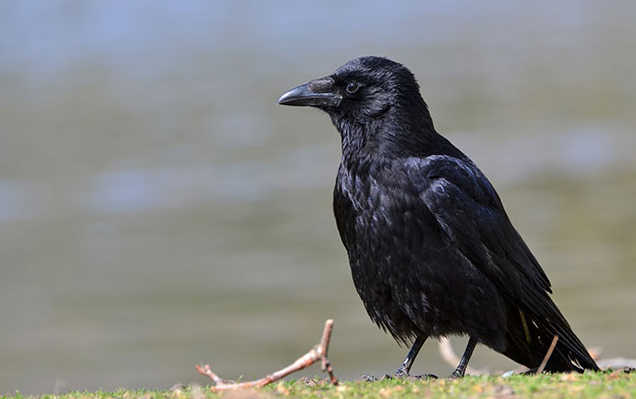
Scientific Name: Corvus corone
Preferred Habitat: Farmland, woodland, parks, gardens, coasts, upland areas In Britain, the carrion crow is often known simply as the ‘crow’. It is a large, black bird that is seen in nearly every type of habitat all across Great Britain.
The carrion crow is a member of the crow family, Corvidae. Members of this family are known as corvids. Like all corvids, the carrion crow is highly intelligent. In fact, it’s one of the most intelligent of all British animals – not just birds!
Carrion crows are similar in size and appearance to rooks. The two species can sometimes be tricky to tell apart.
The best way of telling which is which is by looking at the bird’s face. The carrion crow’s face and beak are black. Short black feathers cover its nostrils.
The rook’s face and bill are pale grey or white, and its nostrils are uncovered.
Crows are often seen alone or in pairs, whereas rooks are more likely to be seen in large groups. However, be careful using this method; crows can often be seen in groups, too.
Chaffinch
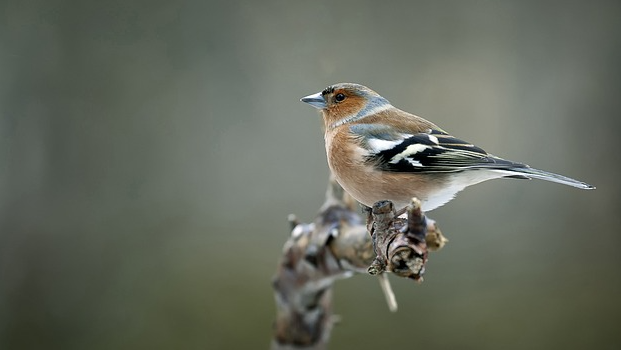
Habitat of Choice: Woodlands, gardens, parks The chaffinch, scientifically known as Fringilla coelebs, is a small and vibrant avian creature. Similar to many other bird species, the males exhibit more brilliant colors compared to their female counterparts. The male chaffinch boasts a reddish face and breast, accompanied by a gray head. Its wings showcase a combination of brown and black hues, adorned with distinct white bars. On the other hand, the female chaffinch possesses a modestly colored breast and head in dull brown, also featuring the distinctive white wing bars.
One can often discern a bird’s dietary preferences by examining its beak. In the case of the chaffinch, it possesses a robust, cone-shaped beak that proves ideal for consuming the seeds that compose the majority of its diet, much like most finches.
During the spring season, the air is often filled with the melodious, descending call of the male chaffinch, resonating from trees and hedgerows.
Collared Dove
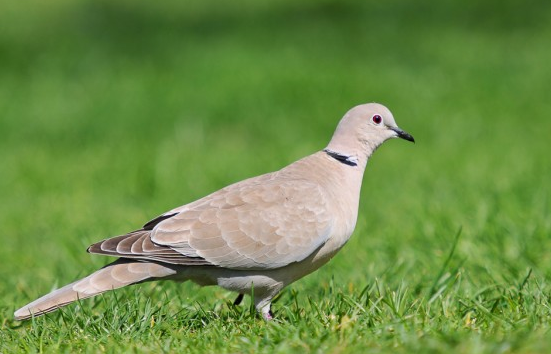
Officially known as Streptopelia decaocto, the collared dove is a fascinating bird that can be found in diverse habitats such as farmland, parks, and gardens. Belonging to the Columbidae family, which encompasses all pigeons and doves, this dove species stands out with its pale, sandy-brown plumage. Its distinct feature is a black band encircling the back of its neck, from which it derives its name. In terms of size, the collared dove is smaller than both the wood pigeon and feral pigeon.
When it comes to vocalization, the collared dove possesses a distinctive three-note call, setting it apart from the wood pigeon’s five-note repetitive call.
Feral Pigeon / Rock Pigeon

Known by its scientific name Columba livia domestica, feral pigeons are the offspring of domestic pigeons that have reacquainted themselves with the wild. Originally bred for consumption, these domestic pigeons trace their lineage back to the rock doves.
While wild rock doves can still be spotted dwelling on cliffs in coastal regions of northern and western Britain, feral pigeons have adapted to thrive in urban environments, particularly towns and cities. Their preferred habitat lies amidst the bustling streets.
Rock doves possess a predominantly gray plumage adorned with black wing bars. Their upper breast and neck exhibit vibrant patches of pink and green.
In contrast, feral pigeons showcase a diverse range of colors. Some closely resemble their rock dove ancestors, while others boast predominantly black or white feathers. Additionally, their plumage may comprise a blend of various shades of gray, white, and brown.
Feral pigeons have established a ubiquitous presence throughout the cities and towns of Britain. In certain locales, such as London’s iconic Trafalgar Square, they have even become a noteworthy attraction for tourists.
Goldfinch

The goldfinch, scientifically known as Carduelis carduelis, is a vibrant and captivating bird found in gardens and grasslands adorned with trees and shrubs. Both male and female goldfinches exhibit striking appearances, boasting red faces and pale brown and white chests. Their wings showcase dark black edges complemented by a vivid yellow-gold bar positioned at the center.
Goldfinches are commonly observed in lively flocks, either busily maneuvering through shrubs and trees or indulging in the consumption of seeds from teasels. Teasels, characterized by their tall and woody nature, bear bushy heads abundant with seeds.
Interestingly, a group of finches, including goldfinches, is referred to as a “charm.” Have you ever had the pleasure of witnessing a charm of goldfinches?
Great Spotted Woodpecker

Scientifically known as Dendrocopos major, the great spotted woodpecker is a woodland dweller that can be found across Great Britain. This medium-sized bird possesses a lengthy and robust beak, perfect for creating holes in trees.
Both male and female great spotted woodpeckers sport a striking black and white plumage, with distinctive red patches near their tails. Additionally, the male boasts a red patch on the back of its neck.
During the British springtime, a familiar sound resonates through the air—the rapid, machine-gun-like drumming produced by the great spotted woodpecker as it forcefully pecks against trees with its beak.
This species displays strong territorial behavior. Through its drumming, the bird communicates a clear message to other great spotted woodpeckers: “Stay away!” It also serves as a means to impress potential mates, showcasing its prowess and attracting the attention of female woodpeckers.
Great Tit
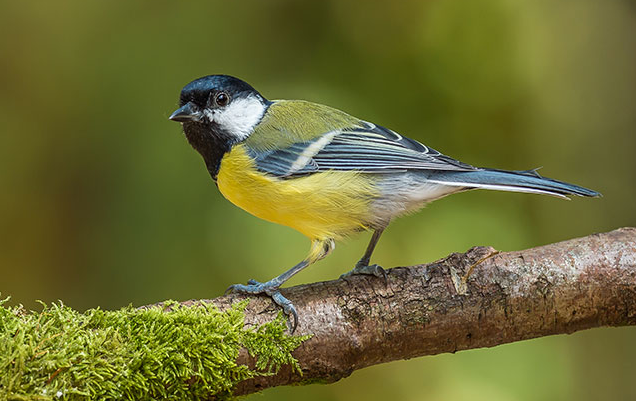
Officially known as Parus major in the scientific community, the great tit is a fascinating creature that can be found dwelling in woodland areas, hedgerows, and even gardens. Belonging to the tit family, Paridae, this bird bears resemblance to its smaller cousin, the blue tit, with its distinct yellow breast and blue-grey wings.
However, distinguishing the great tit from its counterpart is relatively easy once you remember its distinguishing features. Notably larger in size, the great tit boasts an entirely black head adorned with white cheeks.
When it comes to sustenance, the great tit primarily sustains itself by consuming insects and spiders. Additionally, it supplements its diet with seeds and is a frequent visitor to bird tables, demonstrating its adaptability in seeking nourishment.
Grey Heron
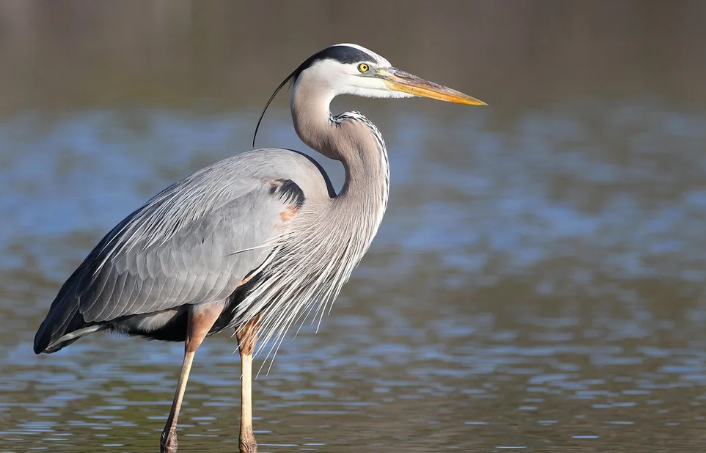
Officially known as Ardea cinerea, the grey heron is a fascinating creature that thrives in wetlands and various bodies of water. In the United Kingdom, it is commonly referred to simply as the ‘heron’. With its elongated neck and grey plumage, this bird is frequently observed perched along the banks of rivers, reservoirs, and ponds. Engaging in a patient hunting strategy, the heron remains motionless for extended periods until it swiftly plunges its lethal beak downwards.
As an apex predator, the heron reigns supreme at the pinnacle of the food chain. Its diet encompasses a diverse array of prey, ranging from fish and frogs to small mammals and even other avian species.
Herring Gull
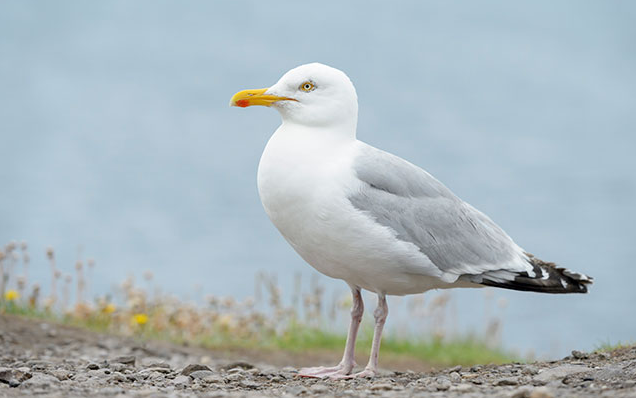
Officially known as Larus argentatus, the herring gull is a sizable marine bird that frequents the shorelines encompassing the entire United Kingdom. This avian species has also become a common sight in urban areas, towns, and even near reservoirs.
Historically, the herring gull established its nests primarily on rugged cliffs. However, it has displayed remarkable adaptability to the expanding human population in Britain by mastering the art of nesting on man-made structures. As a result, the distinctive laughter-like cry of the herring gull can now be heard just as frequently in certain cities as it is along the seaside.
House Sparrow
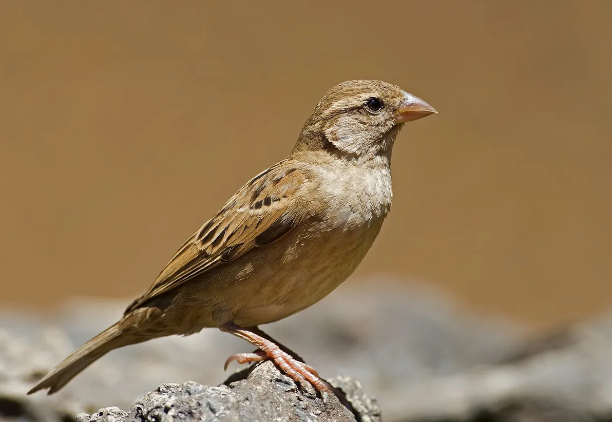
Name: Passer domesticus Habitat Preference: Urban areas such as cities, towns, and villages. The house sparrow, scientifically known as Passer domesticus, is a familiar and cherished bird found in Britain. Renowned for its remarkable ability to coexist with humans, this avian species has maintained a harmonious relationship with us for approximately 10,000 years. In urban environments, the cheerful chirping of a flock of house sparrows can often be heard emanating from hedges and shrubs.
Despite being a widespread and commonly observed bird, the population of house sparrows has experienced a sharp decline in recent times. From 1977 to 2008, their numbers plummeted by a staggering 71%. As a result, this species has largely vanished from numerous cities, becoming increasingly scarce.
Long-Tailed Tit
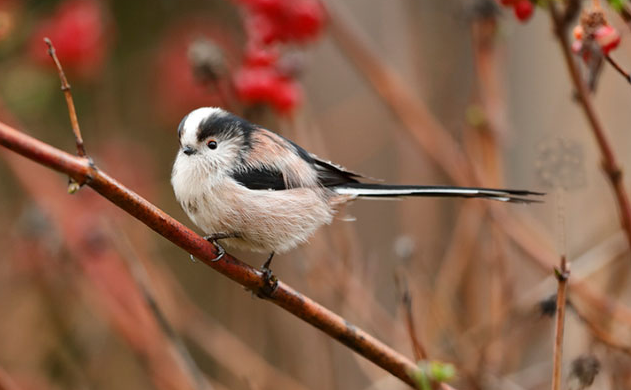
Officially known as Aegithalos caudatus, the long tailed tit is a tiny avian creature that can be found in woodlands as well as in small town and country gardens. Its appearance resembles a fluffy, rounded bundle with an elongated tail. Moving in compact groups, these birds navigate their way through trees and bushes. During winter, they join forces with other small bird species like blue tits and great tits to form foraging parties.
When it’s time to rest, long tailed tits gather together in communal roosts, seeking warmth and companionship. Their nests are skillfully constructed using spider’s webs, moss, and lichen.
Magpie
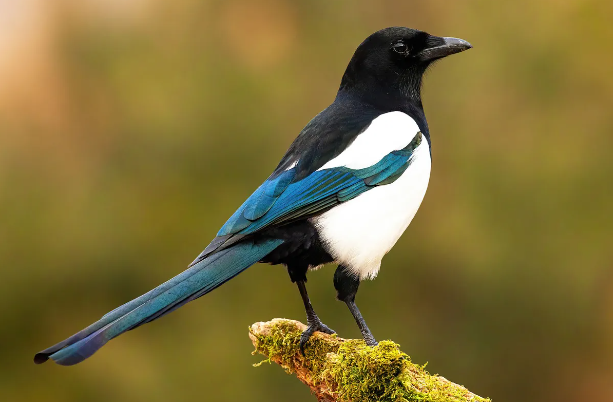
Scientifically classified as Pica pica, the magpie is a familiar avian species in Britain. This crow-like bird stands out with its notable size, contrasting black and white feathers, and a long tail. Its adaptability allows it to thrive in various environments, including towns, farmland, and gardens.
A striking feature of the magpie is its plumage, where the dark portions exhibit a captivating blue-green iridescence, adding to its visual allure. Renowned for its intelligence, this avian creature possesses remarkable cognitive abilities. Astonishingly, it can recognize its own reflection in a mirror, a task that eludes most animals and even many humans below the age of two.
Mallard

Commonly known as the mallard, its scientific name is Anas platyrhynchos. This water-loving duck is frequently encountered in various aquatic environments such as ponds, lakes, rivers, and reservoirs across Britain.
The male mallard boasts a vibrant appearance, with a chestnut-brown chest and a striking metallic green head. In contrast, the female mallard sports a more subdued plumage, predominantly brown in color. However, both genders exhibit attractive blue patches on their wings, accentuated by delicate white borders.
It is worth noting that many domestic duck breeds can trace their lineage back to the mallard, underscoring its importance and influence in the development of various duck populations.
Mute Swan

Commonly known as the mute swan, Cygnus olor is a majestic bird found in the lakes, rivers, and reservoirs of Britain. Standing as one of the largest avian species in the region, it is part of a trio of swan varieties observed in Britain, distinguished by its year-round residence unlike the winter-visiting whooper swan and Bewick’s swan.
With its striking features, the mute swan possesses an orange beak adorned with a notable black protuberance called a ‘knob’ at its apex. Notably, the male’s knob is larger in size compared to that of the female.
In terms of nomenclature, a male mute swan goes by the name of “cob,” while the female is referred to as a “pen.” The offspring of mute swans are charmingly called “cygnets.”
Caution is advised when encountering mute swans, as they have been known to exhibit aggression. These robust creatures should not be approached closely!